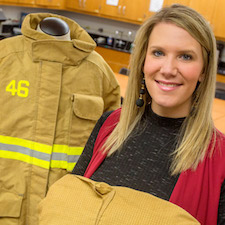A Significant Safety Issue: Women Firefighters Who Work in Gear Designed for Men
Posted on Jan 22, 2020 | Comments 0
 A study by Meredith McQuerry, an assistant professor in the Jim Moran College of Entrepreneurship at Florida State University, finds that due to the fact that most firefighters’ gear is designed for men, women firefighters are hampered in their ability to perform their jobs under dangerous circumstances.
A study by Meredith McQuerry, an assistant professor in the Jim Moran College of Entrepreneurship at Florida State University, finds that due to the fact that most firefighters’ gear is designed for men, women firefighters are hampered in their ability to perform their jobs under dangerous circumstances.
Because of that mismatch, the suits don’t fit as well as they should, and women firefighters’ mobility is impaired. Firefighters working in gear that restricts their movement must work harder to move around in a stressful and physically demanding environment, which puts them at greater risk of overexertion and heart attacks, the leading cause of on-duty deaths.
“There’s not enough research to say 100 percent ‘This is what a female turnout suit needs to be,’ but we do know women need a suit designed for them,” said Dr. McQuerry. “The National Fire Protection Association sees the need. There are female and male sizes, but those are oversimplifications that don’t take different anthropometric proportions into account, like the waist-to-hip ratio, the bust or shoulder breadth.”
Dr. McQuerry measured male and female firefighters in a three-dimensional body scanner, then performed a range-of-motion test and recorded how comfortable they were and how easy it was to move. She found that for both male and female firefighters turnout equipment significantly reduced mobility, but the men and women reported significant differences with the parts of the suit that gave them problems. Women reported more problems with the upper body areas of their turnout suit during overhead activities and were more likely to say that the suits were too large. Men expressed more dissatisfaction with restrictions in the crotch and pant leg during lower-body movements.
“We need more data on female firefighter anthropometrics,” she said. “A little bit has been done, but it is very limited. We need to conduct more research to understand what all of the barriers are along the production pipeline, from the design, to the sourcing, all the way to the purchasing within the fire service.” The goals for an improved turnout suit are clear, she said: “Better performance, less exertion, better safety.”
Dr. McQueery holds two bachelor’s degrees and a master’s degree in textile science from the University of Kentucky. She earned a Ph.D. in textile technology management from North Carolina State University.
The full study, “Effect of Structural Turnout Suit Fit on Female Versus Male Firefighter Range of Motion,” was published in the January issue of Applied Ergonomics. It may be accessed here.
Filed Under: Research/Study








